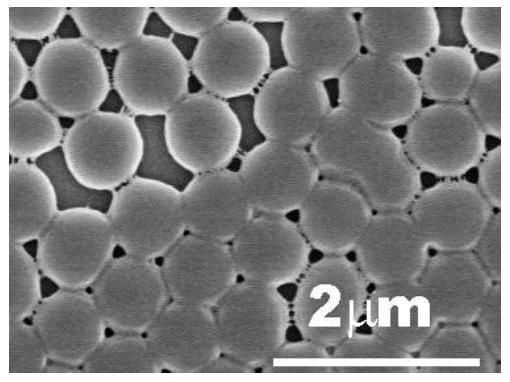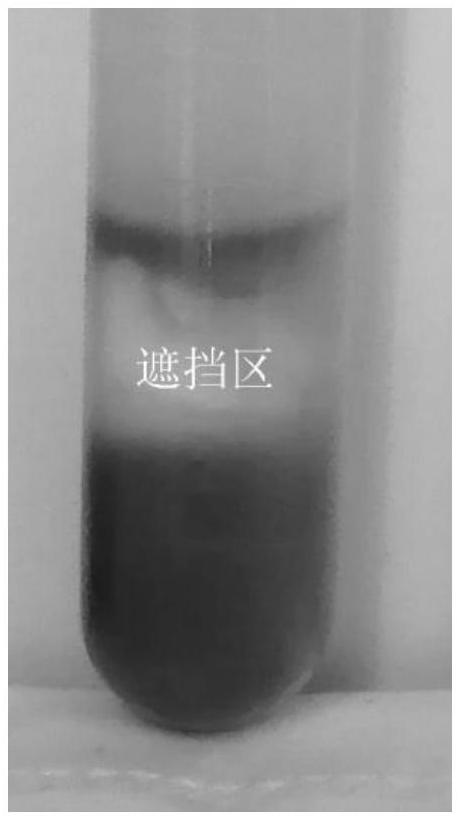Color-changing particle and preparation method thereof
A particle and polymer technology, applied in the field of hybrid color-changing particles containing responsive polymers and inorganic components and their preparation, can solve problems such as limiting the scope of application, and achieve improved color-changing performance, improved color-changing performance, and easy process control. Effect
- Summary
- Abstract
- Description
- Claims
- Application Information
AI Technical Summary
Problems solved by technology
Method used
Image
Examples
Embodiment 1
[0068] Example 1, Preparation of tungsten oxide / poly(N-isopropylacrylamide) intelligent color-changing particles
[0069] Add 10 g of poly(N-isopropylacrylamide) particles (containing N N'-methylenebisacrylamide cross-linking agent in a 250 mL flask, in which N-isopropylacrylamide monomer and N N'-methylene The mass ratio of the base bisacrylamide crosslinking agent is 10:1), add 150mL of water, fully disperse, add 1g of sodium tungstate, stir for 10 minutes, add 10mL of 10M hydrochloric acid, react for 1 hour, centrifuge and wash with water Get smart color-changing particles.
[0070] figure 1 It is the SEM picture of the prepared tungsten oxide / poly(N-isopropylacrylamide) intelligent color-changing particles.
[0071] figure 2 It is a photo of the prepared tungsten oxide / poly(N-isopropylacrylamide) intelligent color-changing particles under ultraviolet irradiation and a photo of visible light irradiation.
[0072] It can be seen from the figure that the tungsten oxide / p...
experiment example 2
[0073] Experimental example 2. Preparation of tungsten oxide / poly(N-isopropylacrylamide-acrylic acid) intelligent color-changing particles
[0074] Add 1 g of poly(N-isopropylacrylamide-acrylic acid) (containing divinylbenzene crosslinking agent, the molar ratio of N-isopropylacrylamide to acrylic acid is 10:1, The addition amount of the joint agent is 2% of the total moles of the two monomers), add 200mL of water, fully disperse and add 2g of potassium tungstate, stir for 1 hour, add 10mL of 1M hydrochloric acid, react for 10 hours, centrifuge, and water Wash well to get smart granules.
[0075] image 3 For the discoloration pictures of the prepared tungsten oxide / poly(N-isopropylacrylamide-acrylic acid) intelligent discoloration particles,
[0076] It can be seen from the figure that the tungsten oxide / poly(N-isopropylacrylamide-acrylic acid) intelligent color-changing particles turn blue-blue after ultraviolet irradiation, and the parts that are not illuminated are yellow....
experiment example 3
[0077] Experimental example 3, preparation of molybdenum oxide / poly(N-isopropylacrylamide) intelligent color-changing particles
[0078] Disperse 0.1g of poly(N-isopropylacrylamide) particles in 200mL of water; then add 0.1g of potassium molybdate and 0.001g of sodium zincate, stir and add 10mL of 1M hydrochloric acid, react for 1 hour and then separate and wash to obtain smart Discoloration particles.
[0079] The color of the molybdenum oxide / poly(N-isopropylacrylamide) particles obtained by irradiating with ultraviolet light changes from yellow to dark blue.
PUM
| Property | Measurement | Unit |
|---|---|---|
| absorption wavelength | aaaaa | aaaaa |
Abstract
Description
Claims
Application Information
 Login to View More
Login to View More - R&D
- Intellectual Property
- Life Sciences
- Materials
- Tech Scout
- Unparalleled Data Quality
- Higher Quality Content
- 60% Fewer Hallucinations
Browse by: Latest US Patents, China's latest patents, Technical Efficacy Thesaurus, Application Domain, Technology Topic, Popular Technical Reports.
© 2025 PatSnap. All rights reserved.Legal|Privacy policy|Modern Slavery Act Transparency Statement|Sitemap|About US| Contact US: help@patsnap.com



